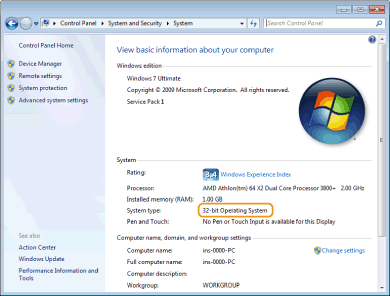The method of installation varies depending on the connection method or environment. * If the User Manual CD-ROM is supplied with the machine, install the e-Manual from the User Manual CD-ROM. | OS | Connection method | Installation method | | Windows | Network connection
(IPv4 environment) | "Installing Using [Easy Installation]"*
"Installing Using [Custom Installation]" | Network connection
(IPv6 environment) | "Installing the MF Drivers on the WSD Network" |
- Presto! PageManager is not installed by selecting [Easy Installation]. To install the software, select [Custom Installation].
- If you are operating in the IPv6 environment, you cannot install the drivers or software following procedures below. Refer to "Installing the MF Drivers on the WSD Network" to install MF Drivers.
- You may not be able to use the scan function in the IPv6 environment.
NOTE User rights for logging on to Windows - Log on as a user with administrative rights.
When installing via network connection - Before starting the installation, check the following.
- The computer and machine are connected via the network. - The power of the machine is turned ON. - The IP addresses are properly set up.
Installing Using [Easy Installation] 1. Insert the User Software and Manuals CD-ROM (or DVD-ROM) into the slot on your computer. 2. Click [Easy Installation]. The options to be displayed differ depending on your country or region. NOTE If the language selection screen is displayed before the CD-ROM/DVD-ROM setup screen appears: - Select the language and click [OK].
REFERENCE If the above CD-ROM/DVD-ROM Setup screen does not appear: - Windows XP and Server 2003
1. From the [Start] menu, select [Run]. 2. Enter "D:\MInst.exe", and then click [OK]. - Windows Vista, 7, and Server 2008
1. Enter "D:\MInst.exe" in [Start Search] or [Search programs and files] under the [Start] menu. 2. Press the [ENTER] key on the keyboard. - Windows 8 and Server 2012
1. Right-click the lower-left corner of the screen and select [Run]. 2. Enter "D:\MInst.exe", and then click [OK]. * The CD-ROM (or DVD-ROM) drive name is indicated as "D:" in this manual. The CD-ROM (or DVD-ROM) drive name may differ depending on the computer you are using.
3. When the following screen appears, select the connection to a computer. Select [Network Connection], and click [Next].
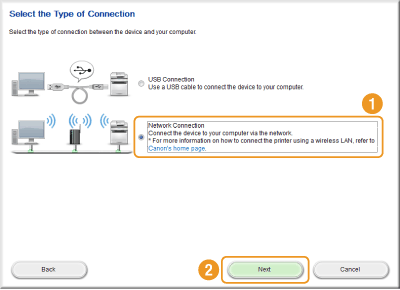 NOTE Windows Server 2003/Server 2008/Server 2012 - This screen is not displayed. Proceed to the following procedure.
4. Click [Install]. The options to be displayed differ depending on your country or region. 5. Read the License Agreement and click [Yes]. 6. Click [Next]. The following screen appears. Click [Yes].
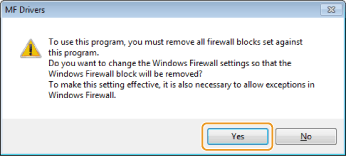 7.Select the machine to be installed. (1) Select the machine. (2) Click [Next].
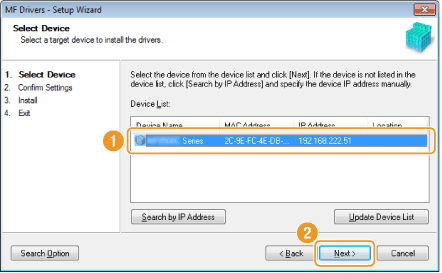 NOTE If no machines are displayed in [Device List]: - Perform the following procedure.
1. Check the following. - The computer and machine are connected via the network. - The machine is turned on. - The IP address is set correctly. - The computer and machine are on the same subnet. - Security software has been exited. 2. Click [Update Device List]. - If any machines are not displayed by performing the above procedure, perform the following procedure.
1. Click [Search by IP Address]. 2. Enter the IP address of the machine to be installed. * If the IP address of the machine is between "169.254.1.0 and 169.254.254.255", the IP address is the one assigned by the AutoIP function. If an IP address other than link-local addresses is set for the computer, set an IP address in the same subnet as the computer (other than link-local addresses) also for this machine manually. This enables the installer to search for this machine. 3. Click [OK].
8.Check the displayed information, and click [Start] to start installation. 9. Click [Exit]. Next, installation of MF Toolbox starts. * In Windows Server 2003/Server 2008/Server 2012, MF Toolbox is not installed. Proceed to step 12. 10. Click [Start].
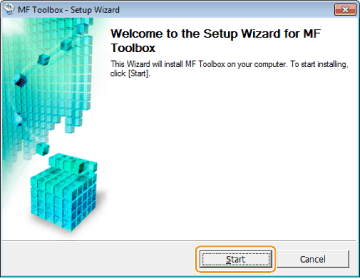 11. Click [Exit].
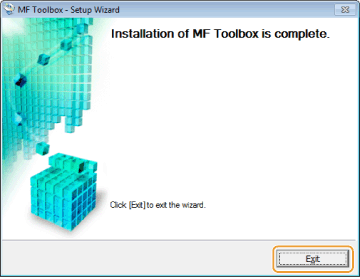 12. Follow on-screen instructions to install the manual. 13. When the following screen appears, read the displayed information, click [Accept] or [Do Not Accept], and then click [Next]. This screen may not be displayed depending on your environment.
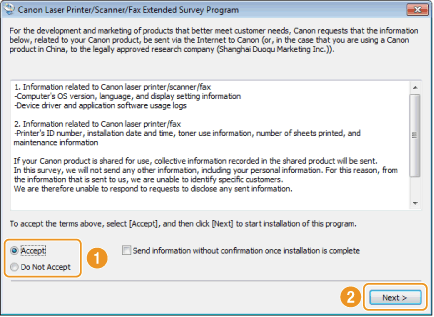 NOTE If you select [Accept]: - The Product Extended Survey Program (the program to investigate the state of usage) will be installed. The Product Extended Survey Program is the program to send the information related to the usage of this machine to Canon every month for ten years. Any other information including your personal information is not sent.
- You can also uninstall the Product Extended Survey Program. See "Uninstalling the Product Extended Survey Program (For Windows)" in the MF Driver Installation Guide.
14. Confirm that the application is selected [  ] under [Install] and click [Next]. The options to be displayed differ depending on your country or region. 15.Restart your computer. (1) Select the [Restart Computer Now (Recommended)] check box. (2) Click [Restart]. * Remove the CD-ROM (or DVD-ROM) once this screen appears. The options to be displayed differ depending on your country or region.  Checking the Installation Results Check if the MF drivers, MF Toolbox, and e-Manual are installed correctly. Check if the following icons are displayed for the installed applications. NOTE About Icons That Are Displayed: - Icons for each driver may be displayed separately or only representative icon may be displayed depending on the operating system.
| Software | Location | Icon | | Printer driver | [Printers and Faxes], [Printers], or [Devices and Printers] folder |
 | | Fax driver | [Printers and Faxes], [Printers], or [Devices and Printers] folder |
 | | Scanner driver | [Scanners and Cameras] or [Scanners and Cameras Properties] folder |
 | | MF Toolbox | Desktop |
 | | Network Scan Utility | Taskbar |
 | | e-Manual | Desktop |
 |
Installing Using [Custom Installation] 1. Insert the User Software and Manuals CD-ROM (or DVD-ROM) into the slot on your computer.
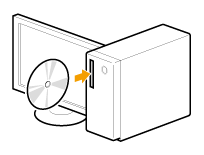 2. Click [Custom Installation]. The options to be displayed differ depending on your country or region. NOTE If the language selection screen is displayed before the CD-ROM/DVD-ROM setup screen appears: - Select the language and click [OK].
REFERENCE If the above CD-ROM/DVD-ROM Setup screen does not appear: Windows XP and Server 2003 1. From the [Start] menu, select [Run]. 2. Enter "D:\MInst.exe", and then click [OK]. Windows Vista, 7, and Server 2008 1. Enter "D:\MInst.exe" in [Start Search] or [Search programs and files] under the [Start] menu. 2. Press the [ENTER] key on the keyboard. Windows 8 and Server 2012 1. Right-click the lower-left corner of the screen and select [Run]. 2. Enter "D:\MInst.exe", and then click [OK]. * The CD-ROM(or DVD-ROM) drive name is indicated as "D:" in this manual. The CD-ROM(or DVD-ROM) drive name may differ depending on the computer you are using.
3. When the following screen appears, select the connection method to a computer. Select [Network Connection], and click [Next].
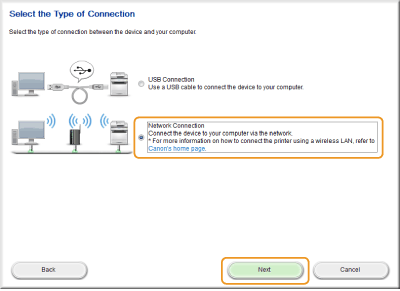 NOTE Windows Server 2003/Server 2008/Server 2012: - This screen is not displayed. Proceed to the following procedure.
4. Select the check box next to the application you want to install and click [Install]. The options to be displayed differ depending on your country or region. 5. Read the License Agreement and click [Yes].
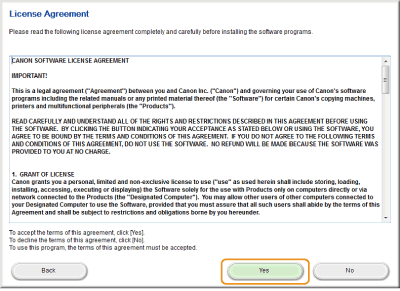 6. Click [Next]. The following screen appears. Click [Yes].
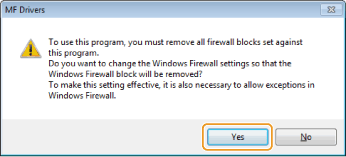 7. Select the machine to be installed. (1) Select the machine. (2) Click [Next].
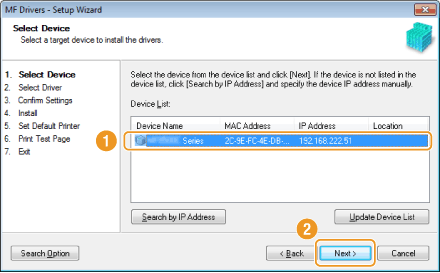 NOTE If no machines are displayed in [Device List]: - Perform the following procedure.
1. Check the following. - The computer and machine are connected via the network. - The machine is turned on. - The IP address is set correctly. - The computer and machine are on the same subnet. - Security software has been exited. 2. Click [Update Device List]. - If any machines are not displayed by performing the above procedure, perform the following procedure.
1. Click [Search by IP Address]. 2. Enter the IP address of the machine to be installed. * If the IP address of the machine is between "169.254.1.0 and 169.254.254.255", the IP address is the one assigned by the AutoIP function. If an IP address other than link-local addresses is set for the computer, set an IP address in the same subnet as the computer (other than link-local addresses) also for this machine manually. This enables the installer to search for this machine. 3. Click [OK].
8. Select the function you want to use. (1) Select the function you want to use (driver to be installed). (2) Click [Next].
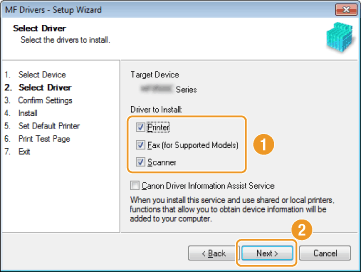
| [Printer] | Select when using the print function. | | [Fax (for Supported Models)] | Select when using the PC fax function. (This function sends documents or images that were created on a computer directly as a fax transmission.) | | [Scanner] | Select when using the scan function. |
If another Select Driver screen is displayed, repeat this step until the Confirm Settings screen is displayed. 9. Set the printer or fax information. (1) Specify the settings for each option as needed. (2) Click [Next].  Printer information*1  Fax information*2 *1 Appears if you selected [Printer] in step 8. *2 Appears if you selected [Fax (for Supported Models)] in step 8. | [Printer Name] | Enter a new name if you want to change the printer or fax name. | | [Fax Name] | | [Use as Shared Printer] | Select the check box to share the printer or fax. | | [Use as Shared Fax] | | [Shared Name] | Change the shared name as needed. |
NOTE If you selected the [Use as Shared Printer] or [Use as Shared Fax] check box: - Install the additional driver as follows.
1. Click [Drivers to Add]. 2. Select the operating system displayed for [Drivers to Add]. 3. Click [OK]. * If a 64-bit operating system is running on a computer on which the installation is being performed, the download installation (installation from a network) for a client computer on which any of the following 32-bit operating systems is running is not supported due to a Windows restriction. - Windows XP (on which no service pack or SP1 is installed) - Windows Server 2003 (on which no service pack is installed) If you download and install the software on any of the above 32-bit operating systems, you may fail to install the software. * If any of the following 32-bit operating systems is running on a computer on which the installation is being performed, the additional driver for a 64-bit operating system cannot be installed. - Windows XP (on which no service pack or SP1 is installed) - Windows Server 2003 (on which no service pack is installed) If you download and install the software on any of the above 64-bit operating systems, you may fail to install the software.
10. Check the displayed information, and click [Start] to start installation. 11. Select the machine you would like to make your default printer. (1) Select the machine you would like to make your default printer. (2) Click [Next]. * This screen appears only when installing the printer driver and fax driver.
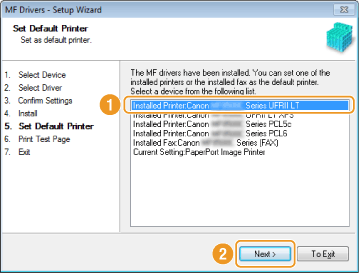 12.Select to print a test page. (1) Select the check box to print a test page. (2) Click [Next]. * This screen appears only when installing the printer driver and fax driver.
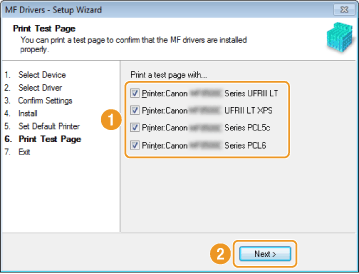 13. Click [Exit]. * Next, installation of MF Toolbox starts. In any of the following cases, MF Toolbox is not installed. - If you are using Windows Server 2003/Server 2008/Server 2012. Proceed to step 18.
- If you did not select the [MF Toolbox] check box in step 4. Proceed to step 16.
14. Click [Next]. The screens for specifying a location in which the MF Toolbox is installed and position to which the start menu is added appear. Specify the settings in the respective screens, and then click [Next]. Click [Start] in the displayed screen.
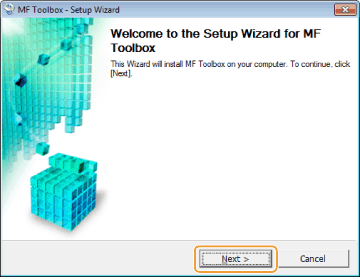 15. Click [Exit]. The software for which the check box was selected in step 4 is installed. Follow the on-screen instructions. 16. If you selected Manuals in step 4, installation of the manuals starts. Follow on-screen instructions to install the manual. 17. When the following screen appears, read the displayed information, click [Accept] or [Do Not Accept], and then click [Next]. NOTE If you select [Accept]: - The Product Extended Survey Program (the program to investigate the state of usage) will be installed. The Product Extended Survey Program is the program to send the information related to the usage of this machine to Canon every month for ten years. Any other information including your personal information is not sent.
- You can also uninstall the Product Extended Survey Program. See "Uninstalling the Product Extended Survey Program (For Windows)" in the MF Driver Installation Guide.
18. Confirm that the applications are selected [  ] under [Install] and click [Next]. The options to be displayed differ depending on your country or region. 19. Restart your computer. (1) Select the [Restart Computer Now (Recommended)] check box. (2) Click [Restart]. Remove the CD-ROM (or DVD-ROM) once this screen appears. The options to be displayed differ depending on your country or region.  Checking the Installation Results Check if the MF drivers, MF Toolbox, and e-Manual are installed correctly. Check if the following icons are displayed for the installed applications. NOTE About Icons That Are Displayed: - Icons for each driver may be displayed separately or only representative icon may be displayed depending on the operating system.
| Software | Location | Icon | | Printer driver | [Printers and Faxes], [Printers], or [Devices and Printers] folder |
 | | Fax driver | [Printers and Faxes], [Printers], or [Devices and Printers] folder |
 | | Scanner driver | [Scanners and Cameras] or [Scanners and Cameras Properties] folder |
 | | MF Toolbox | Desktop |
 | | Network Scan Utility | Taskbar |
 | | e-Manual | Desktop |
 |
Installing the MF Drivers on the WSD Network You can print from a Windows Vista/7/8/Server 2008/Server 2012 computer using the WSD (Web Services on Devices) protocol. To use WSD, follow the procedures in "Installing the MF Drivers" and "Setting WSD" IMPORTANT To enable or disable WSD: - Use the operation panel on the machine.
 Installing the MF Drivers 1. Open the printer folder. From the [Start] menu, select [Control Panel], and then click [Printer]. - For Windows 7/Server 2008
From the [Start] menu, select [Devices and Printers]. - For Windows 8/Server 2012
Right-click the lower-left corner of the screen, select [Control Panel], and then click [View devices and printers]. 2. Click [Add a printer].
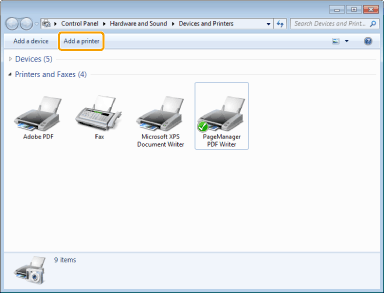 3. Click [Add a local printer].
 4. Confirm that [LPT1: (Printer Port)] is displayed for [Use an existing port] and click [Next].
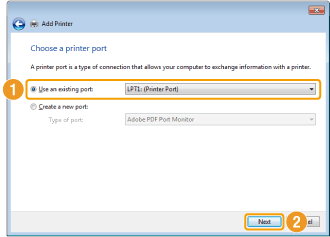 5. Click [Have Disk].
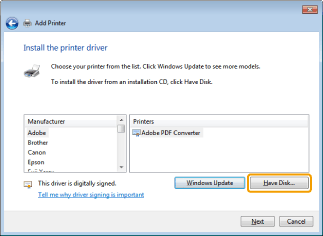 6. Insert the User Software and Manuals CD-ROM (or DVD-ROM) into the slot on your computer. When the following screen appears, click [Exit]. The options to be displayed differ depending on your country or region. NOTE When [AutoPlay] is displayed: - Click [
 ] to close the dialog box. ] to close the dialog box.
7. Click [Browse].
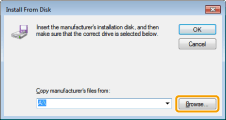 8. Open the folder where the printer driver files are stored. Open [DRIVERS] -> [us_eng] or [uk_eng] -> [32bit] -> [Driver] on the CD-ROM (or DVD-ROM) and click [Open]. Open [DRIVERS] -> [us_eng] or [uk_eng] -> [x64] -> [Driver] on the CD-ROM (or DVD-ROM) and click [Open].
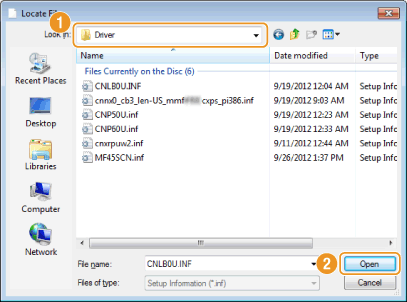 REFERENCE When you are not sure which operating system that you are using on your computer: 1. Open [Control Panel]. - Windows Vista/7/Server 2008:
Select [Control Panel] from [Start] menu. Right-click the lower-left corner of the screen and select [Control Panel]. 2. Display [System]. - Windows Vista/7/8/Server 2008 R2/Server 2012:
Click [System and Maintenance] or [System and Security], and then click [System]. Click [System]. 3. Check the bit architecture. [32-bit Operating System] is displayed. [64-bit Operating System] is displayed.
9. Click [OK].
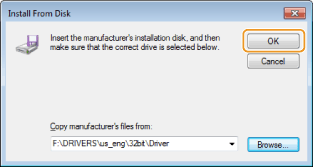 10. Select the printer driver you are using, and then click [Next].
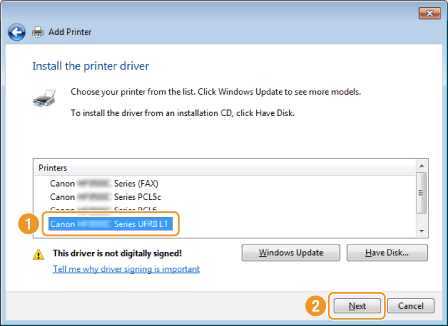 11. Specify the printer name. (1) Enter a different name to change the default printer name. When [Set as default printer] is displayed, specify whether to choose the machine as the default printer (Windows Vista/Server 2008). (2) Click [Next]. Installation begins. Wait until the following screen closes. NOTE When [User Account Control] appears: - Click [Yes] or [Continue].
12. Select [Do not share this printer] and click [Next]. To set the machine as a shared printer, configure the related settings after you have performed the procedure provided in "Setting WSD."
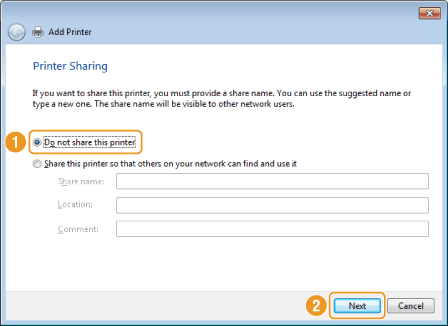 13. Click [Finish]. - When [Set as the default printer] is displayed, specify whether to choose the machine as the default printer (Windows 7/8/Server 2008 R2/Server 2012).
- Eject the CD-ROM (or DVD-ROM) when the following screen appears.
The icon is added to the printer folder.  Setting WSD 1. Open the network folder. - For Windows Vista/Server 2008:
Select [Network] from the [Start] menu. - For Windows 7/Server 2008 R2:
Select [Computer] from the [Start] menu and click [Network]. - For Windows 8/Server 2012
Right-click the lower-left corner of the screen, select [File Explore], and then click [Network]. 2. Right-click the machine icon and select [Install] from the pop-up menu. The icon is add to the printer folder. Installation is complete. NOTE When [User Account Control] appears: - Click [Yes] or [Continue].
Follow the steps in the procedure below to delete the icon added in step 13 of "Installing the MF Drivers," if you do not need it. (1) Right-click the icon and select [Remove device] or [Delete] from the pop-up menu. (2) Click [Yes]. (3) When [User Account Control] appears, click [Yes] or [Continue].
| 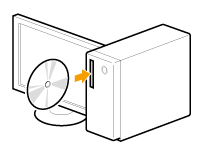
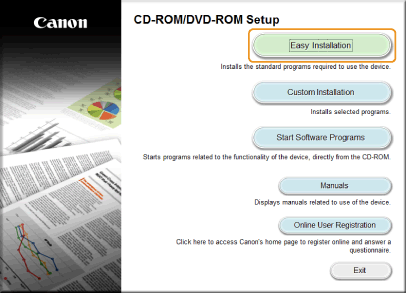

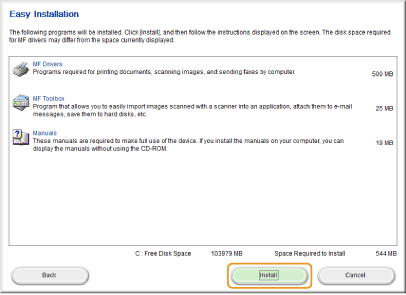
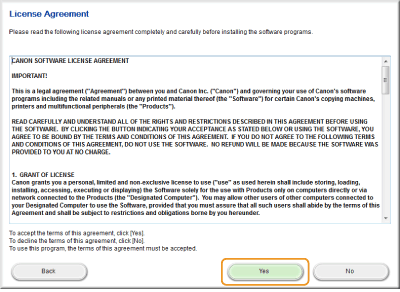
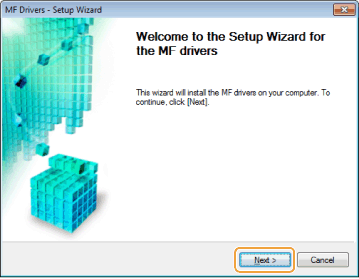


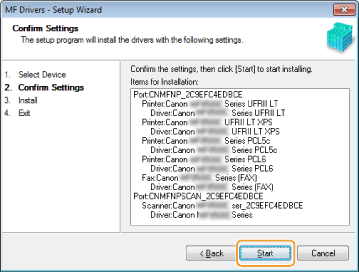

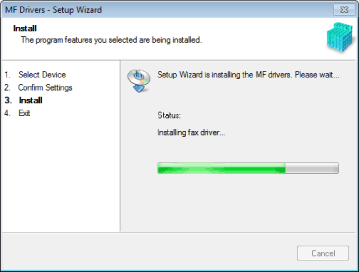
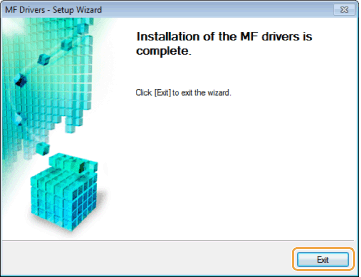



 ] under [Install] and click [Next].
] under [Install] and click [Next].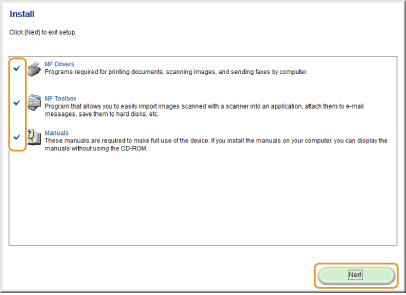
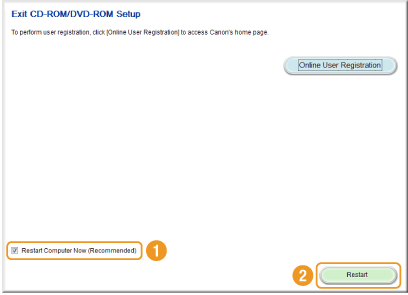
 Checking the Installation Results
Checking the Installation Results
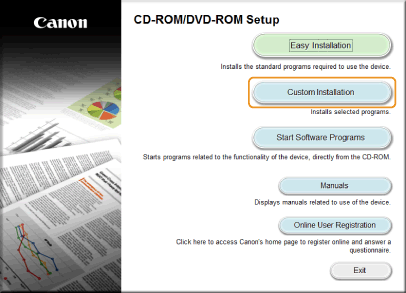

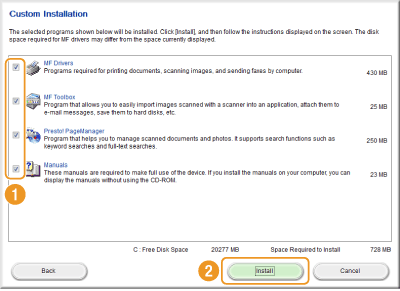

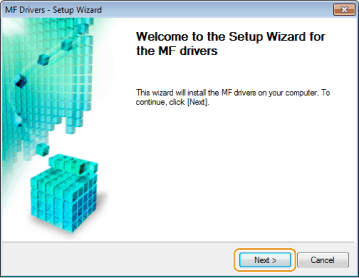



 Printer information*1
Printer information*1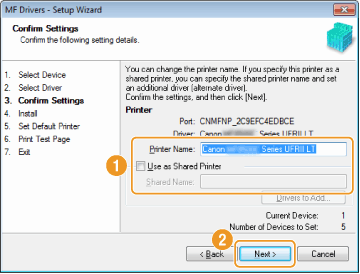
 Fax information*2
Fax information*2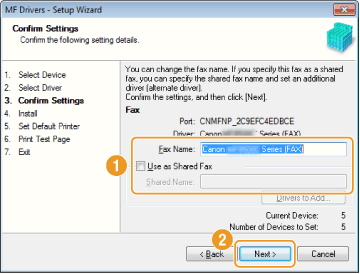
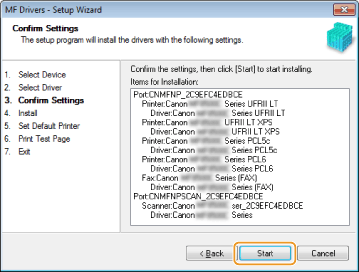

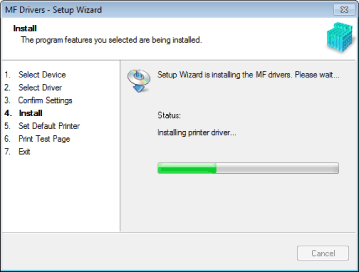


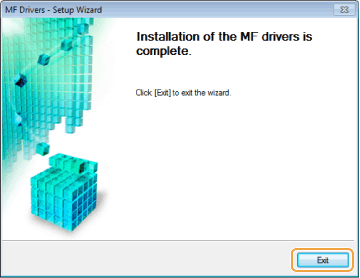

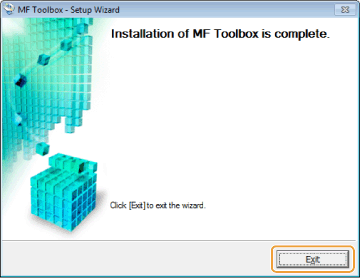
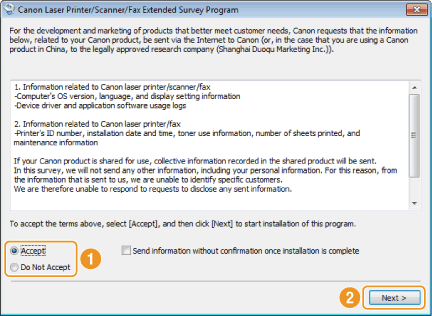
 ] under [Install] and click [Next].
] under [Install] and click [Next].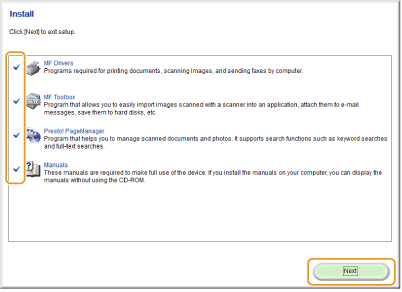
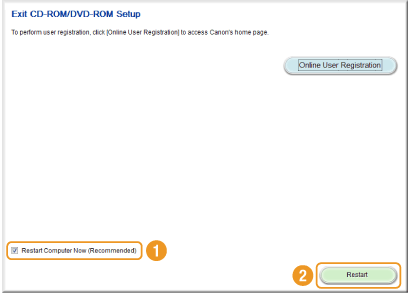
 Checking the Installation Results
Checking the Installation Results Installing the MF Drivers
Installing the MF Drivers



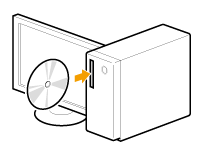
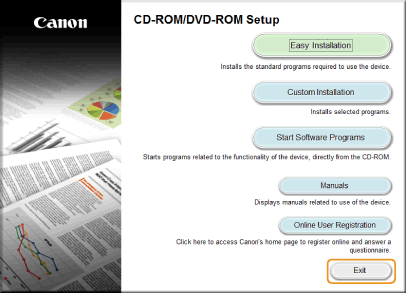




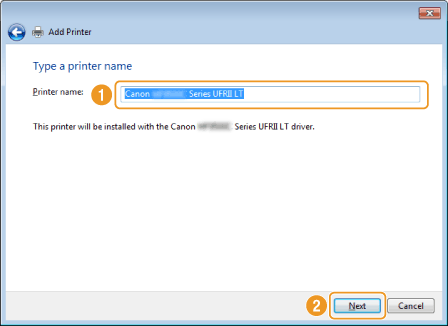
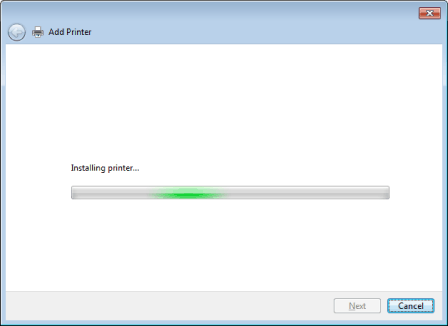

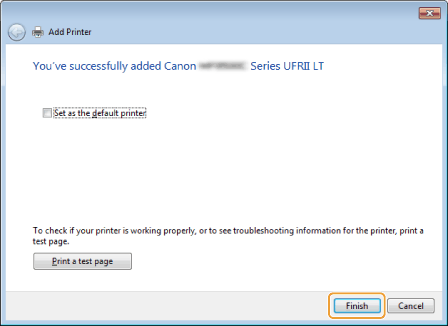
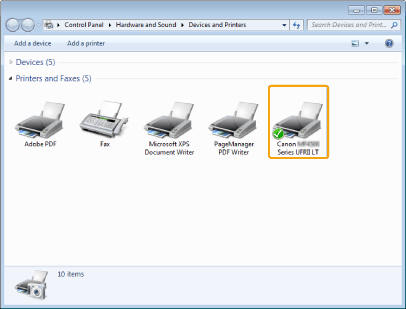
 Setting WSD
Setting WSD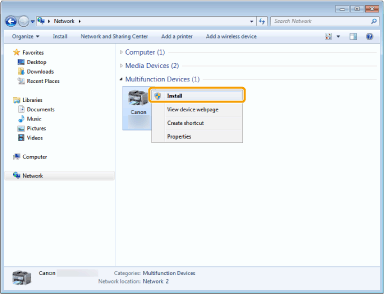
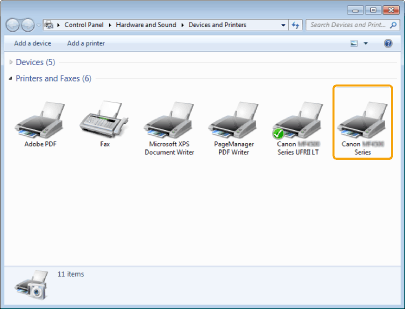









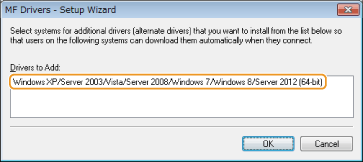
 ] to close the dialog box.
] to close the dialog box.